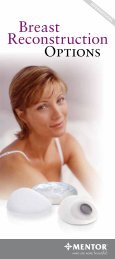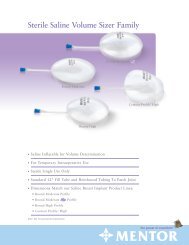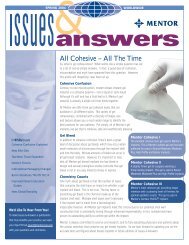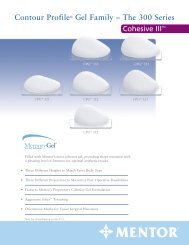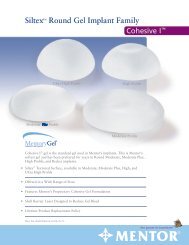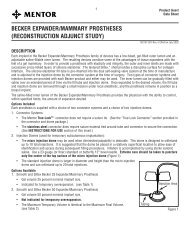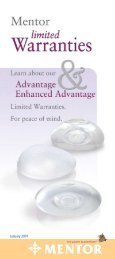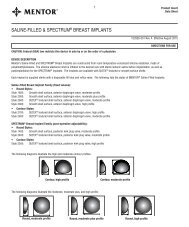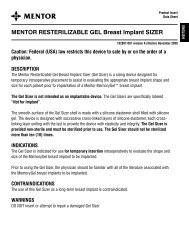Breast Reconstruction Patients Educational Brochure - Mentor
Breast Reconstruction Patients Educational Brochure - Mentor
Breast Reconstruction Patients Educational Brochure - Mentor
- No tags were found...
Create successful ePaper yourself
Turn your PDF publications into a flip-book with our unique Google optimized e-Paper software.
29A surgeon can minimize the chances of these things happening by planning the surgerycarefully and using good surgical techniques. You should understand the possible cosmeticresults and discuss them carefully with your doctor before the surgery. Your surgeoncannot promise that after implant surgery your breast(s) will look exactly as you wantedthem to look. Revision surgery may be the only way to improve a result you do not like.• <strong>Breast</strong> FeedingIf you have a mastectomy and all your breast tissue is removed, you will not be able tobreast feed with that breast. If you have the opposite breast augmented as part of areconstruction (contralateral augmentation), you should know that breast implant surgerymight interfere with your ability to successfully breast feed. It is possible that you willproduce less milk or not be able to produce milk at all. Some women with breast implantshave also reported painful breast feeding. 9,10 If your surgeon uses an incision around thecolored portion surrounding the nipple (periareolar surgical approach), it may furtherincrease the chance of breast feeding difficulties.The Institute of Medicine (IOM) and The American College of Obstetricians andGynecologists (ACOG) encourage women with breast implants to try breast feeding.The IOM concluded, “<strong>Breast</strong> feeding should be encouraged in all mothers whenpossible, including those with silicone breast implants. There is evidence that breastimplantation may increase the risk of insufficient lactation, 11 but no evidence that thisposes a hazard to the infant beyond the loss of breast feeding itself. The evidence for theadvantages of breast feeding to infant and mother is conclusive”. 9,12 The MemoryShape <strong>Breast</strong> Implant Core Study collected information from patients who had babies afterreconstruction with MemoryShape <strong>Breast</strong> Implants. None of the primary reconstructionor revision-reconstruction patients attempted to breast feed through 6 years in<strong>Mentor</strong>’s MemoryShape <strong>Breast</strong> Implant Core Study. Lactation experiences from theMemoryShape <strong>Breast</strong> Implant Core Study are also discussed in Section 8.7.• Implant ExtrusionExtrusion is when the breast implant comes through the skin. This can happen if yoursurgical wound has not healed properly or if the skin over your breast weakens. Radiationtherapy has been reported to increase the chances of implant extrusion. 13 Additionalsurgery is needed to fix implant extrusion. This can result in more scarring or loss of breasttissue. An extruding implant may have to be removed and not replaced.• Necrosis/Delayed Wound HealingNecrosis means that of most or all of the cells in a certain part of your body have died. Inthe case of implanted breasts, it means dead or dying breast tissue or skin. This can meanthat the implant may extrude. Necrotic tissue must be surgically removed. The additionalsurgery may cause more scarring or loss of breast tissue. Your implant may have to beremoved with or without being replaced.Some patients may take a long time to heal after breast implant surgery. The longer ittakes for your surgical wound to close and heal, the greater the risk for infection, implantextrusion, or necrosis. The normal time for wound healing is different for every patient.Infection, radiation, chemotherapy, smoking, taking steroids, and excessive heat or coldtherapy can cause necrosis and delayed wound healing. Be sure to ask your surgeon howlong he or she expects healing to take for you. If you do not heal in that time frame, talk toyour surgeon immediately.• <strong>Breast</strong> Atrophy/Chest Wall DeformityThe breast implant pressing on the breast tissue may cause the tissue to become thinner.When this happens, you may be able to see and/or feel the breast implant through theskin. This tissue thinning can occur while implants are still in place or following implantremoval without replacement.Additional surgery may be needed to correct either of these conditions, which may meanmore scarring, and removal with or without replacement of your breast implant(s).



